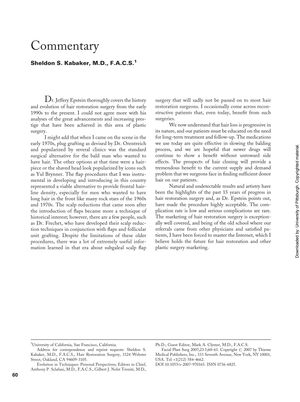Commentary
February 2007
in “
Facial Plastic Surgery
”

TLDR Dr. Sheldon S. Kabaker acknowledges the progress in hair restoration surgery and the shift towards natural results, stressing the need for patient education and future advancements.
In the commentary from 2007, Dr. Sheldon S. Kabaker reflected on the history and advancements in hair restoration surgery, agreeing with Dr. Jeffery Epstein's analysis of the field's progress. Kabaker added his personal experience from the early 1970s, discussing the transition from plug grafting to the development of flap procedures and scalp reductions, which he was instrumental in introducing. He noted that while some older techniques have become of historical interest, they provided valuable information for hair restoration surgery. Kabaker emphasized the importance of educating patients about the progressive nature of hair loss and the need for long-term treatment, expressing hope for future drugs and hair cloning to address donor hair supply issues. He highlighted the past 15 years' focus on natural, undetectable results and low complication rates in hair restoration surgery. Finally, Kabaker touched on the evolution of marketing in the field, particularly the increasing importance of the Internet.




